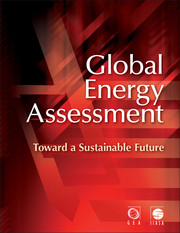Preface
Published online by Cambridge University Press: 05 September 2012
Summary
Today the world of energy has many of the features established in the 20th century:
– Energy consumption grows on average at 2% per year, most of it (80%) originates in fossil fuels
– Energy growth is driven by population growth and economic growth, now predominantly in developing countries and high levels of consumption in the developed countries
– 3 billion people don't have access to basic energy services and have to cook with solid fuels
However, the present path of uninterrupted reliance on fossil fuels poses four challenges to sustainability:
– Soaring greenhouse gas emissions
– Decreasing energy security
– Air pollution at the local and regional levels with resulting health problems
– Lack of universal access to energy services
Most reviews of the energy system needed for the 21st century start with “business as usual” futures and then analyze the effectiveness of specific corrections of course. For many the preferred options are technological fixes such as such as carbon capture and storage (CCS), nuclear energy and even geo-engineering schemes. However, to achieve sustainable development all the needed attributes of energy services, that is availability, affordability, access, security, health, climate and environmental protection, must be met concurrently. The Global Energy Assessment (GEA) accepts this and is unashamedly normative, examining future energy pathways that point to new solutions. The aspirational goals in GEA are defined as:
– Stabilizing global climate change to 2°C above pre-industrial levels to be achieved in the 21st century
– Enhanced energy security by diversification and resilience of energy supply (particularly the dependence on imported oil),
– Eliminating household and ambient air pollution, and
– Universal access to modern energy services by 2030.
- Type
- Chapter
- Information
- Global Energy AssessmentToward a Sustainable Future, pp. xii - xivPublisher: Cambridge University PressPrint publication year: 2012

